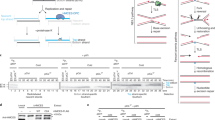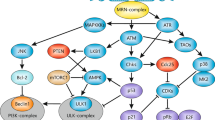Abstract
ADP–ribosyl transferase (ADPRT) is a DNA-dependent nuclear enzyme which covalently attaches ADP–ribose moieties derived from NAD to proteins to form mono- or poly-ADP–ribosyl derivatives1,2. ADPRT activity is strongly stimulated by breaks in DNA3,4 and the enzyme is required for efficient DNA repair5–7. Several reports have suggested that the metabolism of poly- or mono-(ADP–ribose) might also be involved in differentiation in various eukaryotes1,2,8–12. In the most convincing of these, inhibitors of ADPRT were shown to block the differentiation of chick myoblasts in vitro11,12, and differentiation was accompanied by the appearance of single-strand breaks in DNA. We present here evidence that ADPRT activity is obligatory early in the mitogen-induced activation of human peripheral blood lymphocytes. The requirement for this enzyme coincides with a rapid (1–8 h) rejoining of single-strand breaks present in the DNA of quiescent lymphocytes. Hence, DNA breaking and rejoining, regulated by ADPRT, may be involved in a general mechanism of differentiation.
This is a preview of subscription content, access via your institution
Access options
Subscribe to this journal
Receive 51 print issues and online access
$199.00 per year
only $3.90 per issue
Buy this article
- Purchase on Springer Link
- Instant access to full article PDF
Prices may be subject to local taxes which are calculated during checkout
Similar content being viewed by others
References
Hayaishi, O. & Ueda, K. A. Rev. Biochem. 46, 95–116 (1977).
Purnell, M. R., Stone, P. R. & Whish, W. J. D. Biochem. Soc. Trans. 8, 215–227 (1980).
Halldorsson, H., Gray, D. A. & Shall, S. FEBS Lett. 85, 349–352 (1978).
Benjamin, R. & Gill, M. J. biol. Chem. 255, 10493–10508 (1980).
Durkacz, B. W., Omidiji, O., Gray, D. A. & Shall, S. Nature 283, 593–596 (1980).
Gray, D. A., Durkacz, B. W. & Shall, S. FEBS Lett. 131, 173–177 (1981).
Creissen, D. & Shall, S. Nature 296, 271–272 (1982).
Caplan, A. I. & Rosenberg, M. J. Proc. natn. Acad. Sci. U.S.A. 72, 1852–1857 (1975).
Rastl, E. & Swetly, P. J. biol. Chem. 253, 4333–4340 (1978).
Bredehorst, R., Klapproth, K. & Hilz, H. Cell Differentiation 9, 95–103 (1980).
Farzaneh, F., Shall, S. & Zalin, R. in Novel ADP-Ribosylations of Regulatory Enzymes and Proteins (eds Smulson, M. & Sugimura, T.) 217–225 (Elsevier, Amsterdam, 1980).
Farzeneh, F., Shall, S., Brill, D. & Zahlin, R. Nature 300, 362–366 (1982).
Ling, N. R. & Kay, J. E. Lymphocyte Stimulation 2nd edn (North-Holland, Amsterdam, 1975).
Wedner, H. J. & Parker, C. W. Prog. Allergy 20, 195–300 (1976).
Crumpton, M. J., Perles, B. & Auger, J. in International Cell Biology (eds Brinkley, B. R. & Porter, K. R.) 119–127 (Rockefeller University Press, New York, 1977).
Shall, S. J. Biochem., Tokyo 77, 2p (1975).
Purnell, M. R. & Whish, W. J. D. Biochem. J. 185, 775–777 (1980).
Clark, J. B., Ferris, G. M. & Pinder, S. Biochim. biophys. Acta 238, 82–85 (1971).
Cook, P. R. & Brazell, I. A. J. cell. Sci. 22, 287–302 (1976).
Cook, P. R., Brazell, I. A. & Jost, E. J. cell. Sci. 22, 303–324 (1976).
Durkacz, B. W., Irwin, J. & Shall, S. Eur. J. Biochem. 121, 65–69 (1981).
Cook, P. R. & Brazell, I. A. Nature 263, 679–682 (1976).
Vitti, P., De Wolf, M. J. S., Acquaviva, A. M., Epstein, M. & Kohn, L. D. Proc. natn. Acad. Sci. U. S. A. 79, 1525–1529 (1982).
Calabretta, B., Robberson, D. L., Barrera-Saldana, H. A., Lambrou, T. P. & Saunders, G. F. Nature 296, 219–225 (1982).
Weisbrod, S. Nature 297, 289–295 (1982).
Cook, P. R. Nature 245, 23–25 (1973).
MacDermott, A. New Scient. 95, 228–231 (1982).
Johnstone, A. P., DuBois, J. H. & Crumpton, M. J. Biochem. J. 194, 309–318 (1981).
Author information
Authors and Affiliations
Rights and permissions
About this article
Cite this article
Johnstone, A., Williams, G. Role of DNA breaks and ADP-ribosyl transferase activity in eukaryotic differentiation demonstrated in human lymphocytes. Nature 300, 368–370 (1982). https://doi.org/10.1038/300368a0
Received:
Accepted:
Issue Date:
DOI: https://doi.org/10.1038/300368a0
This article is cited by
-
Non-apoptotic Roles of Caspases in Stem Cell Biology, Carcinogenesis, and Radiotherapy
Current Stem Cell Reports (2019)
-
Evolution of caspase-mediated cell death and differentiation: twins separated at birth
Cell Death & Differentiation (2017)
-
Poly(ADP-ribosyl)ation is implicated in the G0–G1 transition of resting cells
Oncogene (2008)
-
Possible involvement of DNA-repair events in the transdifferentiation of mesophyll cells ofZinnia elegans into tracheary elements
Journal of Plant Research (1995)
-
Characterization of the superinduction of the c-myc proto-oncogene in fibroblasts by benzamide derivatives
Molecular and Cellular Biochemistry (1993)
Comments
By submitting a comment you agree to abide by our Terms and Community Guidelines. If you find something abusive or that does not comply with our terms or guidelines please flag it as inappropriate.



